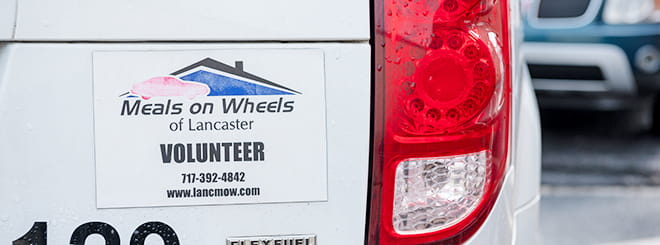
One of the special things about Meals on Wheels of Lancaster is that it’s so much more than its name says it is.
The organization does deliver meals to more than 400 clients every weekday (including holidays), racking up about 325 road miles per day in Lancaster and Chester counties, Pennsylvania.
Drivers deliver one hot meal and one cold meal daily to people who can’t prepare meals for themselves because of age, illness, disability or other limitations.
But Meals on Wheels of Lancaster does a lot more than prepare and deliver food. For example, a Social Call Program addresses feelings of isolation and loneliness that often go along with a lack of mobility.
One-third of the program’s clients say Meals on Wheels volunteers are the only people from outside their households they see on an average day.
“We’re not talking about just seeing their grandkids on weekends – they don’t see anyone at any time,” said Kevin Ressler, M.Div., Executive Director of Meals on Wheels of Lancaster.
“Without mobility, there are more issues than food insecurity,” Ressler said.
Volunteers keep the wheels turning
Ressler credits the caring and hard-working staff and volunteers for helping to stay on top of everything. “The resources we have are people,” he said. The nonprofit has about 500 volunteers and 10 part-time and full-time staff members.
Some volunteers work 9 to 5, Monday through Friday, and may not be able to deliver meals, but still want to help. They can do other things, such as visiting.
“Having someone to call because you’re lonely” can lift the spirits of people who rarely leave home, Ressler noted.
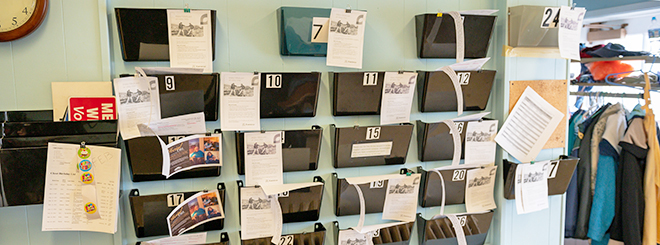
He said, “A youth group might call and say, ‘We have 20 youths who want to volunteer for something.’” They’ll do things like clean gutters, paint a garage, or remove or install a window air conditioner.
“We have staff members in their 20s, 30s, 50s, 60s, 70s and 80s, and one person will turn 40 soon so we’ll have one in their 40s,” Ressler said. “It’s tremendous diversity, which provides different perspectives.”
One woman volunteered to help Meals on Wheels even though she’s unable to leave her home. She writes birthday cards for all of the volunteers and meal recipients.
But how in the world do you manage 500 volunteers – many of them drivers, but some of whom help in the kitchen or in other ways?
Handling the logistical demands
“I like to say that we’re experts at two things,” Ressler said. “One is logistics. All of those meals are delivered within an hour and a half period, every day.”
He said he’d put Meals on Wheels of Lancaster’s on-time delivery record up against UPS, FedEx or the U.S. Postal Service.
“The other thing we’re an expert in is catering. We’re catering the biggest wedding you’ve ever attended, every single day.”
Jean Buch, Dick Long and Don Brubaker (from left) pack and seal bags of food.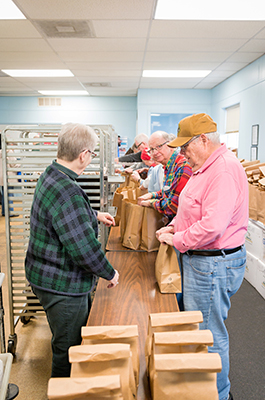
Ressler’s freshman-year roommate at Eastern Mennonite University, Galen Wenger, started a company to create a custom software application for Meals on Wheels programs after serving on the board. Among other things, it keeps track of clients’ case managers, doctors and emergency contact people.
Because meal deliverers interact with people on their routes regularly, they’ll notice if a client’s health appears to be worsening. The Meals volunteer will notify the client’s emergency contact person to describe what they’re seeing.
Keeping track of the details
Computer software keeps track of routes and schedules. The drivers are required to have valid driver’s licenses and insurance, and the Meals on Wheels software notifies staff when a license is about to expire.
Ressler said, “The software is specific to what we do. It also keeps us in compliance with increasing demands from our insurance provider, our government contract and nutritional requirements.”
Each client receives one hot and one cold meal for $8 per day, or $10 for special diets such as vegetarian, gluten-free or therapeutic prescribed diets for people with renal and cardiac issues. All meals are diabetic-friendly and low-fat, without sacrificing flavor.
About half of the organization’s clients actually get their meals free through the Lancaster County Office of Aging, which receives federal and state funding. Some other clients get assistance through SNAP (Supplemental Nutrition Assistance Program).
Meals on Wheels of Lancaster is supported financially by reimbursements from government sources, along with community donations, grants and corporate giving.
Government funding has been shrinking over the years, Ressler said, and some Meals on Wheels organizations have had to put people on a waiting list or not accept government money because increased restrictions don’t match the increased requirements.
New building makes more possible
One way that Meals on Wheels of Lancaster is broadening its base of revenue – as well as increasing services to the community – is the purchase of a restaurant property on Columbia Avenue.
The new building has event space that can be rented for various occasions, and a large commercial kitchen.
“Our capacity grows massively” with the renovated facility, Ressler said. “We’ll have twice as much kitchen space. Actually, we’ll have two kitchens – one for hot foods and one for cold foods. We’ll triple our refrigeration space.”
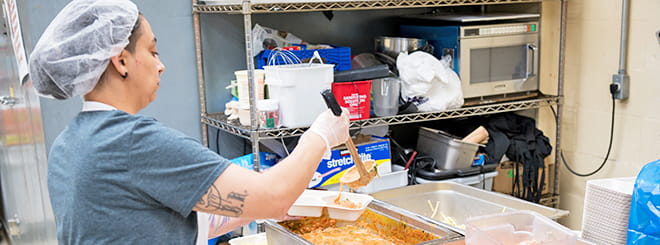
The move is part of a philosophy that stresses always thinking about how the organization can adapt to serve people better, Ressler said.
He said, “How can we reinvent this 50-year-old thing? What haven’t we thought of?”
Moving from a leased building on Manheim Pike into the former restaurant also allows Meals on Wheels to provide job-training services.
Refugees who’ve settled in the Lancaster area, people with disabilities and people who’ve been incarcerated will be trained in kitchen skills.
“First of all, it’s about serving the mission,” Ressler said. “As we grow, we need to increase the number of people helping through volunteering. But it’s also about recognizing we don’t only have to take from volunteers – we can also give back by vouching for people as they apply for jobs after completing our training.”
Ressler is hoping the move to the former restaurant can be completed this spring.
Meals on Wheels of Lancaster also started enrolling eligible people, including homebound clients, to receive SNAP assistance – in partnership with the Central Pennsylvania Food Bank.
“We want to serve the community,” Ressler said. “How we do that is how we choose to do it.”
Innovation paves the way forward
Being on the lookout for more and better ways to help people in need is a driving motivation for Ressler and his staff members’ goal to keep Meals on Wheels of Lancaster fast on its feet.
“Necessity is the mother of invention, but it’s also the mother of innovation,” Ressler said. “We want to be the most innovative organization in the country. We commonly say, ‘Good enough isn’t good enough.’”
Volunteer Dan Cooper (left) talks with Executive Director Kevin Ressler.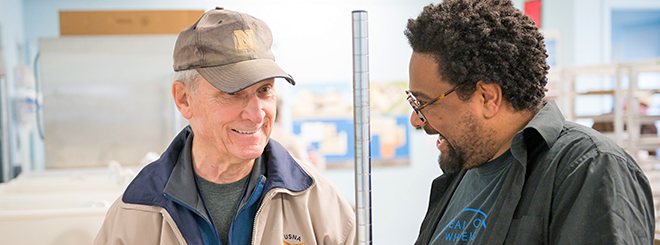
The Meals on Wheels concept originated in London during World War II, when the British Red Cross Society served meals to older adults who’d been bombed out of their homes.
The first meal delivery program in the U.S. started in Philadelphia in 1954. Meals on Wheels of Lancaster was founded in 1967.
Local Meals on Wheels organizations deliver food in thousands of communities across the United States, with more than 2 million staff and volunteers.
Have you thought about volunteering or donating to Meals on Wheels? Visit www.mealsonwheelsamerica.org to find a program near you. Visit www.mealsonwheelsoflancaster.org for more information about Ressler and his team.
Photos by John Martin

